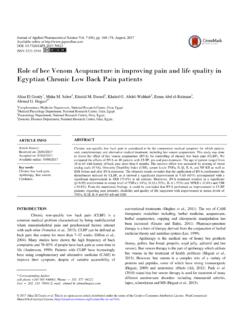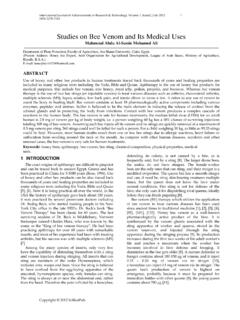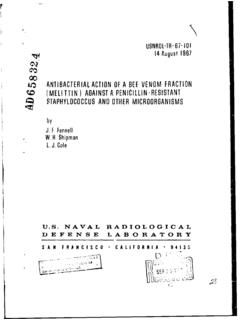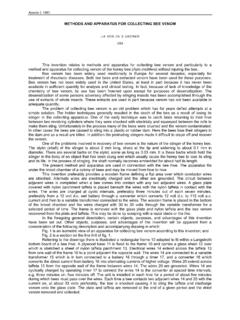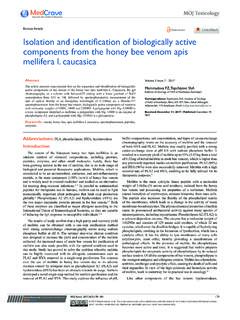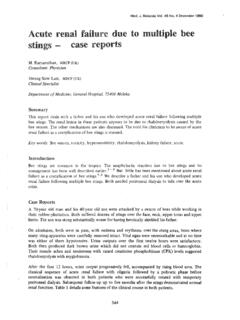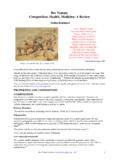Transcription of Bee venom attenuates neuroinflammatory events …
1 RESEARCHOpen AccessBee venom attenuates neuroinflammatoryevents and extends survival in amyotrophiclateral sclerosis modelsEun Jin Yang1*, Jing Hua Jiang1, Sang Min Lee1, Sun Choel Yang2, Hye Suk Hwang1, Myeong Soo Lee1,Sun-Mi Choi1 AbstractBackground:Amyotrophic lateral sclerosis (ALS) is a disease affecting the central nervous system that is eithersporadic or familial origin and causing the death of motor neurons. One of the genetic factors contributing to theetiology of ALS is mutant SOD1 (mtSOD1), which induces vulnerability of motor neurons through proteinmisfolding, mitochondrial dysfunction, oxidative damage, cytoskeletal abnormalities, defective axonal transport,glutamate excitotoxicity, inadequate growth factor signaling, and neuroinflammation.
2 bee venom has been used inthe practice of Oriental medicine and evidence from the literature indicates that BV plays an anti-inflammatory oranti-nociceptive role against inflammatory reactions associated with arthritis and other inflammatory diseases. Thepurpose of the present study was to determine whether bee venom suppresses motor neuron loss and microglialcell activation in hSOD1G93 Amutant : bee venom (BV) was bilaterally injected (subcutaneously) into a 14-week-old (98 day old) malehSOD1G93 Aanimal model at the Zusanli (ST36) acupoint, which is known to mediate an anti-inflammatory measurement of motor activity, rotarod test was performed and survival statistics were analyzed by Kaplan-Meier survival curves.
3 The effects of BV treatment on anti-neuroinflammation of hSOD1G93 Amice were assessed viaimmunoreactions using Iba 1 as a microglia marker and TNF-aantibody. Activation of ERK, Akt, p38 MAP Kinase(MAPK), and caspase 3 proteins was evaluated by western :BV-treated mutant hSOD1 transgenic mice showed a decrease in the expression levels of microglia markerand phospho-p38 MAPK in the spinal cord and brainstem. Interestingly, treatment of BV in symptomatic ALSanimals improved motor activity and the median survival of the BV-treated group (139 days) was 18% greaterthan control group (117 days). Furthermore, we found that BV suppressed caspase-3 activity and blocked thedefects of mitochondrial structure and cristae morphology in the lumbar spinal cord of hSOD1G93 Amice at thesymptomatic :From these findings, our research suggests BV could be a potential therapeutic agent for anti- neuroinflammatory effects in an animal model of lateral sclerosis (ALS) is a severe paralyticdisorder of the central nervous system (CNS) that ischaracterized by age-related degeneration or eliminationofupperandlowerlargemotorneur onsofthemotorcortex, brainstem, and spinal cord [1].
4 ALS symptomsare characterized by muscle weakness, atrophy, spasti-city, and paralysis [2]. Riluzole therapy has been shownto only improve the survival of ALS patients by a fewmonths and has several side-effects, including asthenia,nausea, anorexia, and diarrhea [3]. Therefore, a saferand more effective therapy for ALS patients is needed inorder to reduce the pain associated with this ALS patients have the sporadic form of the disease* Correspondence: of Standard Research, Korea Institute of Oriental Medicine, 483 Expo-ro, Yuseong-gu, Daejeon, 305-811, KoreaFull list of author information is available at the end of the articleYanget of Neuroinflammation2010,7:69 OF NEUROINFLAMMATION 2010 Yang et al; licensee BioMed Central Ltd.
5 This is an Open Access article distributed under the terms of the Creative CommonsAttribution License ( ), which permits unrestricted use, distribution, and reproduction inany medium, provided the original work is properly 5-10% of ALS cases are of the familial type. Famil-ial ALS (fALS) cases are caused by autosomal dominantmutations of the human Cu-Zn superoxide dismutase 1(hSOD1) gene [4]. An animal model of ALS has beencharacterized in mice that carry the mutated hSOD1gene with a glycine to alanine substitution at the 93rdcodon (SOD1G93A). These animals display progressivemotor neuron degeneration that is similar to thatobserved in cases of human ALS [5].In vivoandin vitrostudies using mutant hSOD1 transgenic mice havedemonstrated multiple cellular pathogenic events inmotor neurons such as glutamate excitotoxicity, mito-chondrial dysfunction, protein misfolding, neurofilamentaccumulation, and oxidative stress [2,6,7].
6 Neuroinflammation is a pathological feature present inALS patients and in the mutant hSOD1 mouse model [8].As critical mediators of inflammation, activated microgliaand elevated levels of tumor necrosis factor-alpha(TNF-a) are detected in the CNS of ALS patients and inhSOD1G93 Atransgenic mice [9]. Previous findings pointtowards the critical involvement of microglia in the devel-opment of motor neuron disease; however the nature ofmicroglial-neuronal interactions that lead to motor neurondegeneration remains unknown. One possibility that hasbeen extensively studied in the context of other neurode-generative diseases, especially Alzheimer s disease (AD), isthe notion that chronic and detrimental microglial neu-roinflammation contributes to neuronal degeneration [10].
7 Another study demonstrated that p38, a 38 kDa StressActivated Protein Kinase/Mitogen-Activated ProteinKinase (SAPK/MAPK), has a key role in the developmentof inflammation [11]. Inhibition of p38 has been shown toproduce anti-inflammatory effects by reducing cytokinessuch as TNF-a, interleukin-1 (IL-1), and nitric oxidesynthetase (NOS) as well as by decreasing Cox-2 ininflammatory cells [11]. Elevated levels of TNF-aandTNF-amedicated signaling pathways are evident in alarge number of neurological disorders including multiplesclerosis (MS), AD, Parkinson sdisease(PD),andALS[12-15]. Furthermore, pro-inflammatory cytokines, such asTNF-aand interferon-gamma (IFN-g) have been proposedto be involved in ALS-like microglial activation andinflammation-induced motor neuron death [16,17].
8 bee venom (BV), which is also known as apitoxin, isextracted from honeybees and is commonly used inOriental medicine. The anti-inflammatory action of BVhas shown to reduce pain in patients with chronic rheu-matoid arthritis and osteroarthritis [18]. However, themechanism by which these anti-inflammatory propertiesrelieve the neuroinflammation associated with neurode-generative disease is not clear. In order to explore thistherapeutic mechanism, we investigated the anti-inflam-matory effects of BV on motor function and survival inSOD1G93 Amutant present study showed decreased levels of TNF-aand the deactivation of p38 MAPK downstream of theTNF-asignaling pathway in both the brainstem and spinalcord of hSOD1G93 Amice after treatment with BV in thehind limbs at the ST36 acupoint.
9 Interestingly, BV treat-ment reduced the number of microglial cells and astro-cytes, and dramatically increased the expression of MAP2in motor-related regions of the brainstem and spinal cordin comparison with age-matched hSOD1G93 Acontrolmice. Additionally, we showed that BV suppressed cas-pase-3 activity and reduced the disruption of mitochon-drial structure and cristae morphology in the lumbarspinal cord of hSOD1G93 Amice. Furthermore, BV treat-ment improved the motor coordination and prolonged thelife span of familial mutant ALS animals at a symptomaticstage. Based on these findings, we suggest that BV has aneuroprotective effect against motor neuron cell deathand suppresses neuroinflammation-induced disease pro-gression in symptomatic ALS mice mice were handled in accordance with the guidelinesof the United States National Institutes of Health(Bethesda, MD).
10 The protocols were approved by theInstitutional Animal Care and Use Committees of theKorea Institute of Oriental Medicine. Hemizygous trans-genic B6 SJL mice carrying a glycine to alanine base pairmutation at the 93rdcodon of the cytosolic Cu/Znsuperoxide dismutase gene (hSOD1G93A) were originallyobtained from the Jackson Laboratory (Bar Harbor,ME). Transgenic mice were identified by PCR asdescribed previously [4]. The hSODG93 Amice developedthe initial signs of neuromuscular deficits, such as legtremors and loss of the hindpaw extension reflex, atapproximately 15 weeks of age. At 16 weeks, theyshowed marked locomotor impairment with paralysisand muscular atrophy of the hind limbs.
